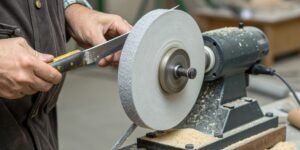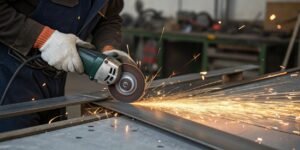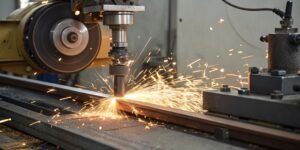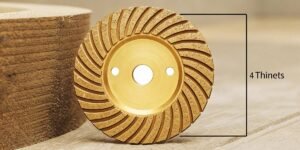
What should be avoided when grinding tools on the grinder?
Are you worried about safety accidents or damaged equipment during grinding? Simple mistakes can lead to major problems. Following key safety rules ensures a smooth, efficient process every time.
To ensure safety, always avoid improper wheel selection and installation. Make sure you use adequate personal protection. Never use irregular workpiece clamping methods, and always monitor your process parameters and cooling.

In my nearly three decades in the grinding tool industry here in Henan, I’ve seen it all. The difference between a master craftsman and a novice often comes down to their respect for the machine and the process. These aren’t just rules; they are habits that protect you, your workpiece, and your equipment. Let’s break down the most critical things you must avoid to achieve perfect, safe results.
What are some things you should avoid doing working on a grinding machine?
Do you feel exposed when operating a grinding machine? Loose clothing or hair can turn a routine job into a disaster. Protecting yourself is the first step to quality work.
Never work without proper personal protective equipment (PPE). This includes safety glasses and appropriate clothing. Always stop the machine completely before you load, unload, or measure a workpiece. Your hands should never be near a moving wheel.

At our Reliable factory, safety isn’t just a poster on the wall; it’s our culture. We learned early on that carelessness is the biggest enemy of precision. You should always wear your safety glasses. A small metal filing can cause permanent eye damage. Also, avoid wearing gloves when operating bench grinders, as they can get caught in the spinning wheel. Wear a sturdy apron and never operate with an open shirt. If you have long hair, make sure it is tied back and secured under a cap. Finally, patience is a virtue. Never try to measure a workpiece while the machine is running. Always stop the spindle and move the wheel to a safe position first. These small habits make a huge difference in your personal safety and the quality of your work.
What should you not do with a grinder?
Have you ever seen a grinding wheel shatter? It’s a terrifying experience caused by simple, avoidable mistakes. Using the wrong wheel or installing it improperly risks everything.
Never use a grinding wheel that is past its expiration date or shows any signs of cracks or damage. Always ensure it is installed correctly, with clean flanges that are tightened just right. A poorly mounted wheel is a serious safety hazard.

It sounds basic, but wheel selection and installation are where many problems start. We produce millions of wheels, and each one is designed for a specific purpose. Using the wrong one is inefficient and dangerous. Before you mount any new wheel, perform a "ring test1" by tapping it gently. A good wheel will have a clear ring; a dull thud indicates a possible crack. When installing, make sure the flanges are clean and flat. Don’t overtighten the nut, as this can stress the wheel and cause it to break. After installation, always run the new wheel idle for a few minutes while standing to the side, not in front of it. This simple test confirms the wheel’s stability before you ever touch it to a workpiece. These steps prevent accidents and ensure our RL diamond wheels perform at their best.
What four things should you avoid when using angle grinders?
Do you find angle grinders hard to control? These powerful tools can kick back unexpectedly, causing injuries. Mishandling the tool or workpiece puts you in immediate danger.
With an angle grinder, you must avoid four key things. Never use a cracked disc. Do not remove the safety guard. Never hold small workpieces by hand. And avoid applying sudden, forceful pressure.

Angle grinders are versatile but demand respect. We see many clients who use them for everything, so we stress these four points.
- Inspect the Disc: Like with larger machines, always check your disc for cracks before use. A shattered disc at 11,000 RPM is a projectile.
- Keep the Guard On: The guard is there for a reason. It deflects sparks and will contain fragments if the disc breaks. Removing it is asking for trouble.
- Secure Your Work: Never hold a small piece of metal in one hand and grind it with the other. The tool can easily grab the piece and pull your hand into the disc. Use clamps or a vise.
- Apply Gentle Pressure: Don’t force the tool into the material. Let the speed of the disc do the work. Jamming it can cause a violent kickback.
Mastering these habits turns a dangerous tool into a powerful and safe one for any job.
What are the safety precautions when using a surface grinder?
Are you getting burn marks or cracks on your finely finished surfaces? This often points to problems with your process, not just the tool. Incorrect parameters can ruin hours of work.
For surface grinding, check your magnetic chuck’s holding power before you start. Use a slow, gentle feed rate. Ensure consistent coolant flow for wet grinding and never switch from dry to wet grinding on a hot workpiece.

Achieving high precision on a surface grinder is an art. It’s all about control. Before you start, always make sure your workpiece is held firmly. If you are using a magnetic chuck, check its suction power, especially for small or thin parts. When you begin grinding, don’t jam the wheel into the workpiece. Your initial contact should be very light, followed by a slow, steady feed. This prevents the wheel from taking too big of a bite, which can cause it to break. For wet grinding, consistent coolant is critical. If your coolant flow2 stops, stop the machine immediately. A sudden change in temperature from coolant loss or from trying to wet-grind a hot, dry piece can cause thermal shock3, cracking both the workpiece and your expensive grinding wheel.
| Action to Avoid | Why It’s a Problem | What to Do Instead |
|---|---|---|
| Sudden Feed | Stresses and breaks the wheel | Approach the workpiece slowly and gently |
| Weak Clamp/Hold | Workpiece can move or fly off | Check magnetic chuck strength; use clamps |
| Interrupted Coolant | Causes thermal shock and cracks | Ensure constant flow; stop if it fails |
Conclusion
Avoiding these common mistakes will protect you and your equipment. It ensures high-quality results, better efficiency, and a safer workshop for everyone.
-
Learning about the ring test can help you ensure the safety and integrity of your grinding wheels before use. ↩
-
Learning about coolant flow can prevent overheating and damage to both the workpiece and grinding wheel. ↩
-
Understanding thermal shock can help you avoid costly damage and ensure safe grinding operations. ↩
Written by
leeon
You may also be interested in:

How to use a hard felt bench grinding wheel on knives?
Getting a razor-sharp, polished edge on a knife can be frustrating and slow. A dull knife is dangerous, and using the wrong tool can easily

What are grinding cracks and how do you stop them?
Are tiny cracks appearing on your ground surfaces? This problem leads to part failure, wasting time and money. You can solve it by understanding the

What does an angle grinder do that other tools can't?
Struggling with tools for multiple tasks? Carrying a heavy toolbox is inefficient. An angle grinder replaces many tools, saving you time and effort on the

How to reduce the cycle time in a grinding machine?
Is your grinding process a major bottleneck? Slow cycle times hurt your bottom line and delay deliveries. You can speed up production by optimizing key

Do you regularly sharpen your chisels? If so, how?
A dull chisel ruins wood and causes frustration. This wastes time and expensive materials. Learning to sharpen correctly is the simple, game-changing solution you need

How is a grinding wheel specified?
Confused by the codes on a grinding wheel? Making the wrong choice costs money and ruins parts. Let me show you how to read them
